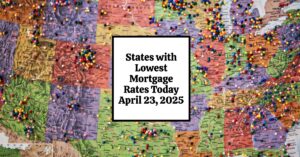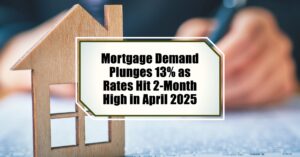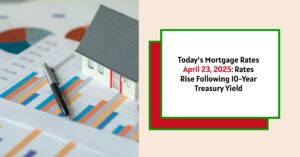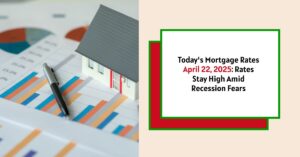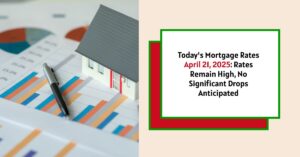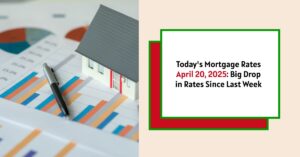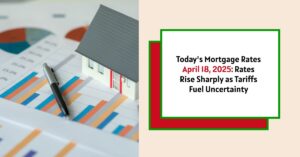Looking for the states with the cheapest mortgage rates today? As of April 23, 2025, you'll find the most attractive 30-year fixed mortgage rates in New York, Pennsylvania, and California. These states currently boast some of the lowest averages, but it's crucial to remember that rates are always changing, and your individual circumstances will play a big role.
It can be a jungle out there when you’re trying to buy a home. It feels like everyone is speaking a different language filled with confusing terms and numbers. One thing that is clear is that mortgage rates are a HUGE deal. Even a tiny difference in the rate can add up to tens of thousands of dollars over the life of the loan.
So, let’s break down the current mortgage rate situation and see which states are offering the best deals and what impacts the rates.
States With the Lowest Mortgage Rates Today – April 23, 2025
According to recent data from Zillow, these states are showing the most promising 30-year fixed mortgage rates (Investopedia):
- New York – 6.90%
- Pennsylvania – 7%
- California – 7.01%
- Washington – 7.04%
- Connecticut – 7.05%
- Louisiana – 7.05%
- Michigan – 7.05%
- New Jersey – 7.05%
- New Mexico – 7.05%
- South Carolina – 7.05%
These states registered average rates between 6.90% and 7.05%.
And the Most Expensive States for Mortgages
On the flip side, here are the states where you'll find the highest mortgage rates as of today:
- West Virginia – 7.15%
- Alaska – 7.14%
- Indiana – 7.12%
- Maryland – 7.12%
- Arizona – 7.11%
- Colorado – 7.11%
- Hawaii – 7.11%
- Kentucky – 7.11%
- Nevada – 7.11%
- Utah – 7.11%
The average rates in these states range from 7.11% to 7.15%.
Important Note: These are just averages. The actual rate you qualify for will depend on your credit score, down payment, income, and other factors.
Why Do Mortgage Rates Vary by State?
You might be wondering, “Why are mortgage rates different from one state to another?” It’s a great question, and there are several reasons:
- Different Lenders: Not all lenders operate in every state. This means there is less competition, and they can get away with slightly higher rates.
- State-Level Regulations: Some states have regulations that impact the cost of doing business for lenders, which can affect rates.
- Credit Scores and Loan Sizes: The average credit score and loan size can vary from state to state, which can influence the risk profile for lenders.
- Risk Management: Lenders have different risk management strategies. Some might be more willing to offer lower rates in certain areas based on their assessment of the local market.
National Mortgage Rate Trends
Let's take a step back and look at the bigger picture of mortgage rates across the country:
- Current National Average (30-year fixed): As of April 23, 2025, the national average for a 30-year fixed-rate mortgage is around 7.07%.
- Recent Fluctuations: Rates had dropped 20 basis points last week, but then increased 11 basis points over the last four days. This highlights how quickly rates can change.
- Past Trends: Last month, rates dipped to a low of 6.50%, which was the cheapest average of 2025. Back in September, they even hit a two-year low of 5.89%.
National Averages of Lenders' Best Mortgage Rates
| Loan Type | New Purchase |
|---|---|
| 30-Year Fixed | 7.07% |
| FHA 30-Year Fixed | 7.37% |
| 15-Year Fixed | 6.19% |
| Jumbo 30-Year Fixed | 7.12% |
| 5/6 ARM | 7.39% |
Don't Fall for Teaser Rates!
Be careful when you see those super-low mortgage rates advertised online. These “teaser rates” often come with strings attached, such as:
- Paying Points: You might have to pay extra upfront fees (points) to get the lower rate.
- Ultra-High Credit Score: The rate might only be available to borrowers with near-perfect credit.
- Smaller Loan Amount: The rate might be for a smaller loan than you need.
The rate you actually get will be based on your unique financial situation.
Factors That Determine Your Mortgage Rate
Several things influence the mortgage rate you'll qualify for:
- Credit Score: A higher credit score generally means a lower interest rate.
- Down Payment: A larger down payment can reduce the lender's risk and potentially lower your rate.
- Income: Lenders want to see that you have a stable income and can afford your monthly payments.
- Debt-to-Income Ratio (DTI): This is the percentage of your monthly income that goes towards debt payments. A lower DTI is generally better.
- Loan Type: Different loan types (e.g., fixed-rate, adjustable-rate, FHA, VA) come with different interest rates.
- Property Location: As we've seen, rates can vary by state.
Read More:
When Will the Soaring Mortgage Rates Finally Go Down in 2025?
Mortgage Demand Plunges 13% as Rates Hit 2-Month High in April 2025
Why Are Mortgage Rates Rising Back to 7%: The Key Drivers
What Makes Mortgage Rates Rise and Fall?
Understanding the forces that drive mortgage rates can help you time your home purchase more effectively. Here are some of the main factors at play:
- The Bond Market: Mortgage rates often track the yield on the 10-year Treasury bond.
- The Federal Reserve (The Fed): The Fed's monetary policy, especially its bond-buying programs and the federal funds rate, can influence mortgage rates.
- Competition: Competition between mortgage lenders can drive rates down.
In the past, the Fed's actions had a huge impact. For example, during the pandemic, the Fed bought billions of dollars in bonds to keep interest rates low. However, when the Fed started to reduce these purchases and raise interest rates to fight inflation, mortgage rates went up significantly.
The Fed's Recent Decisions
The Federal Reserve has been carefully managing interest rates to combat inflation. They aggressively raised the federal funds rate in 2022 and 2023. However, they started making slight rate cuts toward the end of 2024. As of early 2025, the Fed has opted to hold rates steady, and it's uncertain when the next rate cut will occur. This uncertainty adds complexity to the mortgage market.
Shopping Around Is Key
Here's my top advice: Always shop around for the best mortgage rate! Don't just go with the first lender you talk to. Get quotes from multiple lenders and compare their rates, fees, and terms. This can save you a lot of money over the long haul.
Use a Mortgage Calculator
To estimate your potential monthly mortgage payment, use a mortgage calculator. You can enter your home price, down payment, loan term, and interest rate to get a sense of what you might pay each month.
Example:
- Home Price: $440,000
- Down Payment: $88,000 (20%)
- Loan Term: 30 years
- Interest Rate: 6.67%
Estimated Monthly Payment: $2,649.04
Remember that this is just an estimate. Your actual payment will also include property taxes, homeowners insurance, and potentially private mortgage insurance (PMI) if your down payment is less than 20%.
The Bottom Line
Finding the states with the cheapest mortgage rates is a good starting point, but remember that your individual situation will ultimately determine the rate you qualify for. By understanding the factors that influence mortgage rates and shopping around for the best deal, you can increase your chances of securing a loan that fits your budget and helps you achieve your homeownership dreams.
Work With Norada, Your Trusted Source for
Real Estate Investment in the U.S.
Investing in turnkey real estate can help you secure consistent returns with fluctuating mortgage rates.
Expand your portfolio confidently, even in a shifting interest rate environment.
Speak with our expert investment counselors (No Obligation):
(800) 611-3060
Also Read:
- Will Mortgage Rates Go Down in 2025: Morgan Stanley's Forecast
- Expect High Mortgage Rates Until 2026: Fannie Mae's 2-Year Forecast
- Mortgage Rate Predictions 2025 from 4 Leading Housing Experts
- Mortgage Rates Forecast for the Next 3 Years: 2025 to 2027
- 30-Year Mortgage Rate Forecast for the Next 5 Years
- 15-Year Mortgage Rate Forecast for the Next 5 Years
- Why Are Mortgage Rates Going Up in 2025: Will Rates Drop?
- Why Are Mortgage Rates So High and Predictions for 2025
- Will Mortgage Rates Ever Be 3% Again in the Future?
- Mortgage Rates Predictions for Next 2 Years
- Mortgage Rate Predictions for Next 5 Years
- Mortgage Rate Predictions: Why 2% and 3% Rates are Out of Reach
- How Lower Mortgage Rates Can Save You Thousands?
- How to Get a Low Mortgage Interest Rate?
- Will Mortgage Rates Ever Be 4% Again?
